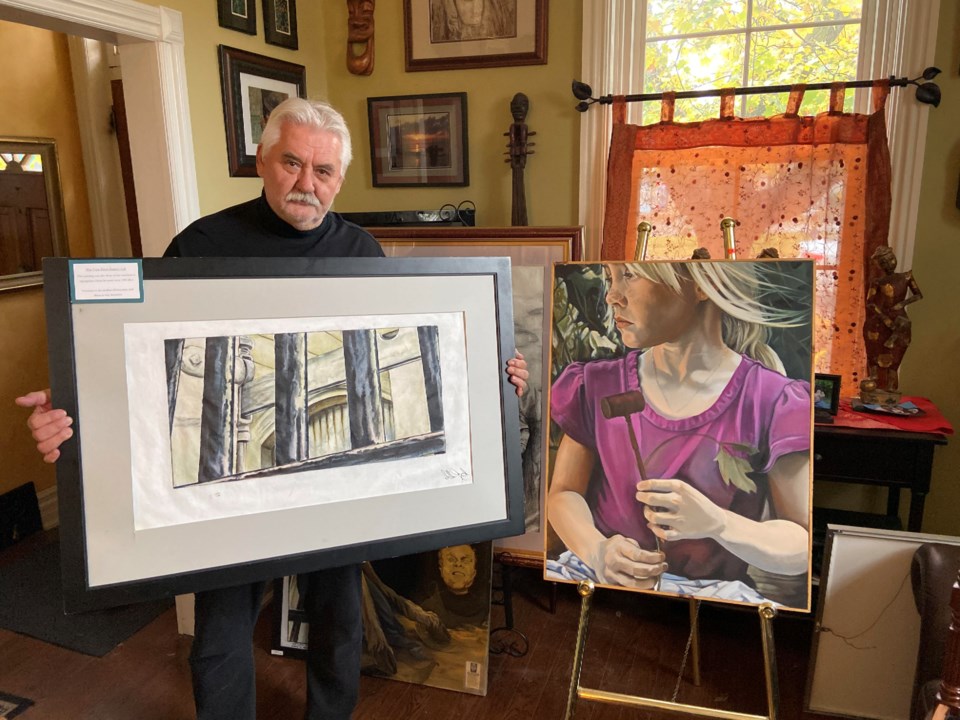The curator of an upcoming showing of artwork made by people who are incarcerated says many are surprised by the quality of the images, but if prisoners have one thing working in their favour to hone their skills, it’s time.
Garry Glowacki worked for many years as the executive director of a prison ministry before retiring, helping men and women reintegrate into society after prison.
Glowacki also collected so-called ‘prison art’ over the past 25 years.
“Some were given to me and some I purchased,” said Glowacki.
A showing of works from Glowacki’s collection will be shown Nov. 21 at HOPE House on Cork Street in a show titled Art Inside Out: From the Hearts and Souls of Men and Women Imprisoned.
Glowacki said when he has shown the works in the past, the one thing that surprises people the most is the quality of the paintings and drawings.
“I think the artwork itself is very controversial, but it’s interesting and good art,” he said. “People are amazed at the level of talent. Some people would not believe they were done by prisoners.”
“Nobody has asked me why I waste my time doing this,” said Glowacki. “It’s not universally well received — nothing is. But overall it seems to be well received. It’s interesting and provocative. Prison art has sort of a different flavour to it.”
The works can also be very raw and emotional.
“When you see drawings of prison cells, that’s not normal — especially when you think that’s the view from his house. That’s what they call their cell,” said Glowacki.
Because of a scarcity of materials, art created in prison can be highly improvised. Bed sheets or tablecloths can be made into a canvas. Any number of materials can be used to draw the image.
“There are very limited supplies in prison, as you can imagine,” said Glowacki.
One thing prisoners have an abundance of is time to craft their works.
Glowacki hopes to raise money to resurrect a prison art program and to purchase supplies for the artists.
“It’s been a calling for me and a passion,” he said.
Artists to be featured in the show include Brian Martland, who painted while in solitary confinement, and current Guelph resident Wayne Forest, who has credited art with helping him reintegrate into society.
A piece by Terry Baker features the logo of a chocolate bar that she was given while incarcerated at Grand Valley Institution. Baker later took her own life in the same cell that Ashley Smith did in 2017.
“That’s really powerful stuff,” said Glowacki.
The show is being organized in recognition of Restorative Justice Month and will also include a number of speakers on the topic.
Glowacki said restorative justice is not necessarily about crime, but the breaking of relationships.
“It’s not forgive and forget — I will forgive you, but I’m not going to forget,” said Glowacki.
In his years working with the ministry, Glowacki has seen a lot of positive change from prisoners and people who were formerly incarcerated.
“The majority of people coming out of jail come out with nothing, literally. Depending on how much help they get, they can just be really angry. Some just go back to jail because it’s home. Some get high and die,” said Glowacki.
Investing time and energy into helping those men and women after they regain their freedom not only helps the person, but society as a whole, said Glowacki.
He should know. Prior to his ministry work, Glowacki was once on the other side of the prison bars as an inmate.
“Nobody can tell me people can’t change — I personally am a heroin addict,” said Glowacki. “Now I am clean and sober for 28 years, back at university and spent a lot of time working with men a lot like me.”
“For many years my push was to be as bad as I could be. Thankfully those days are over and I am still alive,” he said.
“I have overdosed, I have been shot and I have been stabbed, but I am good now. I am good with where I am in my life. I am a good grandfather,” said Glowacki. “I am a good man.”
Art Inside Out will be held Nov. 21 from noon to 4 p.m. at HOPE House.
